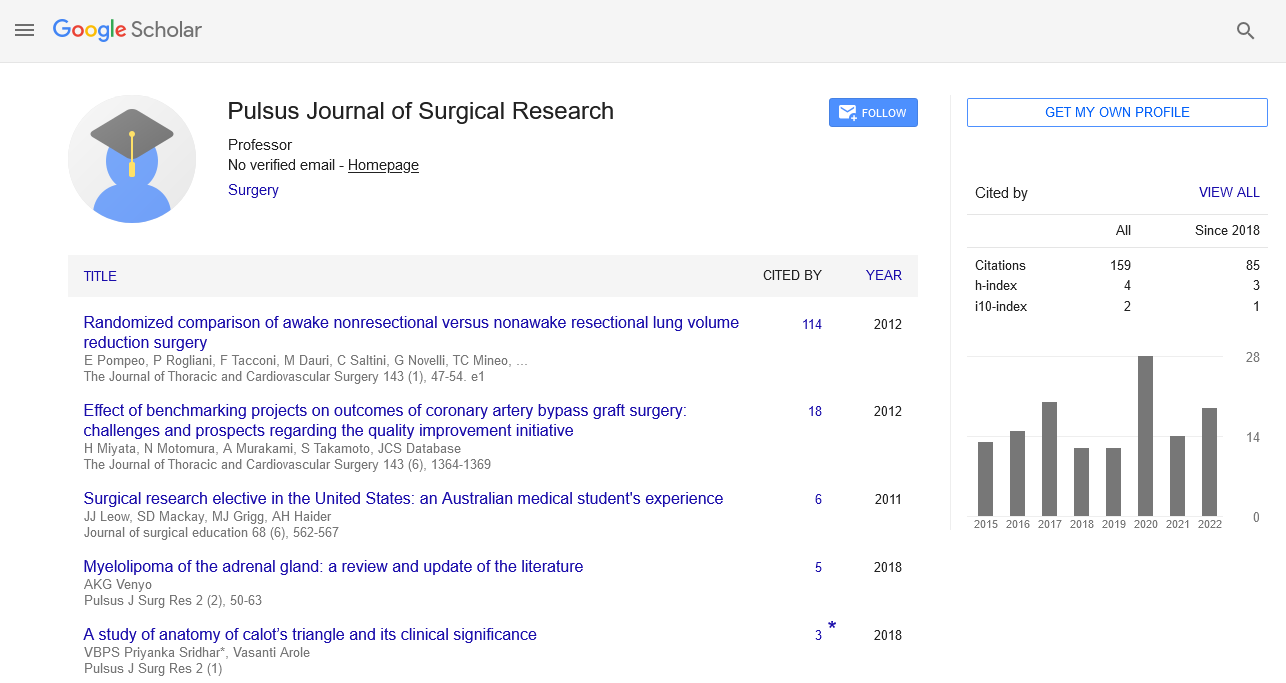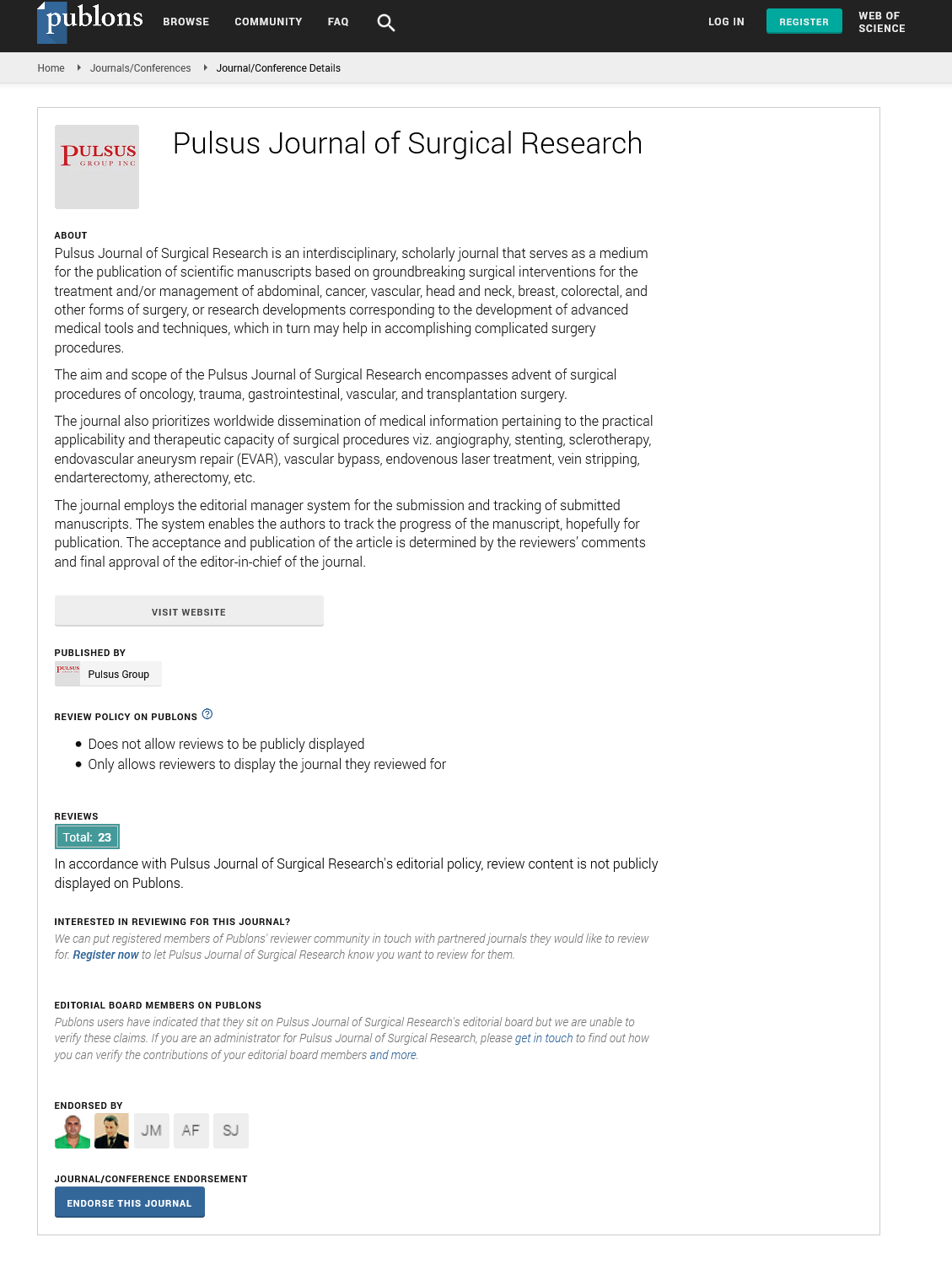Letter to the editor: two interesting cases of brunner's gland polyposis
Received: 27-Mar-2018 Accepted Date: Apr 29, 2018; Published: 18-Apr-2018
Citation: Brady C, Lavryk O, Wey J, et al.. Letter to the editor: two interesting cases of brunner's gland polyposis. Pulsus J Surg Res. 2018;2(1):40.
This open-access article is distributed under the terms of the Creative Commons Attribution Non-Commercial License (CC BY-NC) (http://creativecommons.org/licenses/by-nc/4.0/), which permits reuse, distribution and reproduction of the article, provided that the original work is properly cited and the reuse is restricted to noncommercial purposes. For commercial reuse, contact reprints@pulsus.com
Abstract
Brunner’s gland polyposis is a rare tumor of the gastrointestinal tract that is typically asymptomatic and often only found incidentally on upper gastrointestinal endoscopy. We present 2 complex cases of a patients unusual presentations with Brunner’s gland polyps.
Dear Editor
Brunner’s gland polyposis is a rare tumor of the gastrointestinal tract that is typically asymptomatic and often only found incidentally on upper gastrointestinal endoscopy. We present 2 complex cases of a patients unusual presentations with Brunner’s gland polyps.
A 54-year-old female presented with several years history of regurgitation and abdominal pain. She had a complex surgical history beginning in 1977 with a Bilroth II reconstruction and antrectomy for gastric outlet obstruction. In 1989, she was diagnosed with Puetz-Jegher’s syndrome due to an abundance of duodenal and small intestinal polyps identified on CT and so underwent duodenectomy and conversion of her Bilroth II to a Bilroth I. Histopathology demonstrated Brunner’s gland hyperplasia in all resected polyps. In 2001, she underwent open Roux-en-Y gastrojejunostomy for ongoing biliary reflux, however, she continued to have issues with pain and malnutrition and became TPN dependent. An EGD at this time identified several further duodenal polyps which were biopsied, demonstrating Brunner’s gland hyperplasia and features suspicious for adenocarcinoma. A CT scan demonstrated innumerablerr duodenal and jejunal polyps, that had increased in size since the previous study. There was also an increase in biliary and pancreatic duct dilatation, secondary to ampullary compression by the polyps. She therefore underwent a classic pancreatoduodenectomy along with a proximal jejunal resection. The specimen demonstrated greater than 100 benign Brunner’s gland polyps, measuring up to 6cm in size but no malignancy was identified. Post-operatively, she recovered well and was finally able to tolerate oral intake.
Our second case was of a 60-year-old gentleman with a history of melena. At presentation he was found to be severely anaemic, with a haemoglobin of 4 mg/dl. Prior to transfer he had undergone a thorough investigation including EGD which had revealed a duodenal mass. Biopsies taken at that time were reported as reactive epithelial changes only. A CT scan revealed a 4.4 x 4.1 cm mass in the second part of the duodenum closely related to the ampulla with associated duodenal distension. He was transfused a total of eight units of blood and two units of FFP during the course of his admission. His case was discussed in the multidisciplinary team meeting including review of the radiology and histopathology. The lesion appeared resectable and he underwent exploratory laparotomy at which time a soft tissue mass could be palpated within the lumen of the duodenum. A 6 cm pedunculated mass was resected. Final histopathology revealed a wellencapsulated submucosal mass, filled with clear serous fluid. The mucosa had a granular lobulated appearance consistent with Brunner’s gland hyperplasia. He was last seen at 12-month follow-up and was symptom free.
Brunner’s gland polyposis is a rare diagnosis in an already unusual subset of duodenal tumours. In the literature, the words Brunner’s gland polyposis, hyperplasia, adenoma and hamartoma are used somewhat interchangeably, confusing the picture. They are typically asymptomatic and picked up incidentally on endoscopy [1]. The condition was first described in 1876 and since then less than 200 cases have been reported in the literature [2].
The etiology of Brunner’s gland polyposis has been debated in the literature for many years. It typically presents in the 5th and 6th decades of life with an equal gender predominance [3]. Since Brunner’s glands provide an “anti-acid” role, there is a hypothesis that high levels of acid secretion may lead to hyperplasia of the Brunner’s glands [4]. The theory proposes that as a protective mechanism, Brunner glands multiply to produce increasing amounts of alkaline fluid in response to gastric acid hypersecretion.
The management of Brunner’s gland polyposis remains controversial. Many of the cases of Brunner’s gland polyposis are asymptomatic and whether or not these need treatment is debatable. There is one school of thought which maintains that if asymptomatic, they do not need excision, however, as described above the risk of serious bleeding from these masses often leads to pre-emptive resection [1]. By removing polyps before they become symptomatic, the need to emergently operate should hopefully be significantly reduced.
These cases highlight symptomatic lesions, which clearly required resection. They were both very unusual presentation and so were of interest to all of the members of our MDT.
Yours Sincerely,
Miss Chevonne Brady
Core Surgical Trainee
BMSc, MBChB, MRCS, PGCert
REFERENCES
- Sorleto M, Timmer SA, Wuttig H, et al. Brunner’s Gland Adenoma – A Rare Cause of Gastrointestinal Bleeding: Case Report and Systematic Review. Case Reports in Gastroenterology 2017;11:1-8.
- Euanorasetr C, Sornmayura P. Surgical management of Brunner's gland hamartoma causing upper GI hemorrhage: Report of two cases and literature review. Journal of the Medical Association of Thailand 2010;93:1232-1237.
- Gokhale U, Pillai GR. Large Brunner’s Gland Hamartoma: A Case Report. Oman Medical Journal 2009;24:41-43.
- Levine JA, Burgart LJ, Batts KP, Wang KK. Brunner’s gland hamartomas: clinical presentation and pathological features of 27 cases. Am J Gastroenterol 1995;90:290-294.






